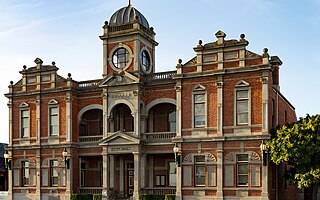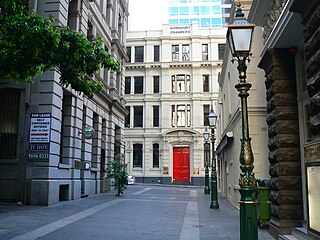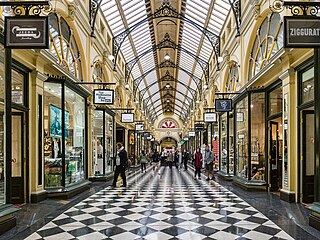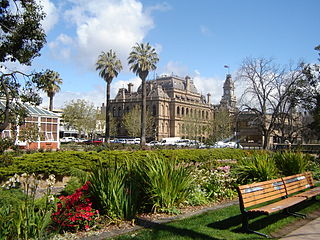
Bendigo is a city in north-central Victoria, Australia, located in the Bendigo Valley near the geographical centre of the state and approximately 150 kilometres (93 mi) north-west of Melbourne, the state capital.

Castlemaine is a town in west central Victoria, Australia, in the Goldfields region about 120 kilometres northwest by road from Melbourne and about 40 kilometres from the major provincial centre of Bendigo. It is the administrative and economic centre of the Shire of Mount Alexander. The population at the 2021 Census was 7,506. Castlemaine was named by the chief goldfield commissioner, Captain W. Wright, in honour of his Irish uncle, Viscount Castlemaine.

The City of Greater Bendigo is a local government area in Victoria, Australia, located in the central part of the state. It covers an area of 3,000 square kilometres (1,200 sq mi) and, in August 2021, had a population of 121,470. It includes the city of Bendigo and the towns of Axedale, Elmore, Heathcote, Marong, Raywood and Strathfieldsaye. It was formed in 1994 from the amalgamation of the former City of Bendigo with the Borough of Eaglehawk, Shire of Strathfieldsaye, Shire of Huntly and parts of the Rural City of Marong and Shire of McIvor. It is the state's third largest economy base and is considered a service and infrastructure centre for north central Victoria. The city is surrounded by 40,000 hectares of regional, state and national parkland.

Queenscliff is a small town at the south-eastern end of the Bellarine Peninsula in southern Victoria, Australia. It lies south of Swan Bay at the entrance to Port Phillip. It is the administrative centre for the Borough of Queenscliffe. At the 2021 census, Queenscliff had a population of 3,276.

QV Melbourne or just QV, is a precinct in the Melbourne CBD, Victoria, Australia. Covering the city block bounded by Lonsdale, Little Lonsdale, Swanston, and Russell Streets, and located next to the State Library of Victoria, QV comprises a large shopping centre, a central plaza, an underground food court, Melbourne city's first full-size supermarket and apartment buildings.

Bendigo Senior Secondary College (BSSC) is an Australian government-funded co-educational secondary school for Year 11 and Year 12 students located in the centre of Bendigo, Victoria. It is the largest provider of VCE, VCE Vocational Major and VET in the state of Victoria.
The Melbourne Sports and Entertainment Centre is a sports administration and training facility located in the Melbourne Sports and Entertainment Precinct in Melbourne, Australia. The facility opened in 1956 as an aquatic centre for the 1956 Olympic Games. In 1983, the Olympic-sized pool was replaced with a parquetry floor and the facility became Melbourne's home of numerous basketball events until 1998, most notably as the home venue for several National Basketball League teams including the North Melbourne Giants and Melbourne Tigers. The venue served as Melbourne's primary indoor concert arena from 1984 to 1988, until completion of the Rod Laver Arena.

Bank Place is a street in the Melbourne central business district, Australia. It is a laneway running roughly north-south between Collins Street and Little Collins Street.

The Royal Arcade is a historic shopping arcade in the central business district of Melbourne, Victoria, Australia. Opened in 1870, it connects Bourke Street Mall to Little Collins Street, with a side offshoot to Elizabeth Street. It is the oldest surviving arcade in Australia, known for its elegant light-filled interior, and the large carved mythic figures of Gog and Magog flanking the southern entry.
Australian non-residential architectural styles are a set of Australian architectural styles that apply to buildings used for purposes other than residence and have been around only since the first colonial government buildings of early European settlement of Australia in 1788.

The Shire of Huntly was a local government area immediately to the northeast of the regional city of Bendigo, Victoria, Australia. The shire covered an area of 878 square kilometres (339.0 sq mi), and existed from 1866 until 1994.

The Shire of McIvor was a local government area about 110 kilometres (68 mi) north of Melbourne, the state capital of Victoria, Australia. The shire covered an area of 1,295 square kilometres (500.0 sq mi), and existed from 1863 until 1994.

The Goldfields region of Victoria is a region commonly used but typically defined in both historical geography and tourism geography. The region is also known as the Victorian Golden Triangle.

The Shamrock Hotel, currently trading as Hotel Shamrock, is a grand 19th-century hotel in Bendigo, Victoria, Australia, situated on Pall Mall, the city's main street.
Williams Boag, now known under the name WILLIAMS BOAG architects (WBa), is a Melbourne-based architectural practice that describes itself as a socially responsible design practice with a focus on modernist principles. Aesthetically Williams Boag's designs most closely resemble that of contemporary Scandinavian architecture. Williams Boag is a company with a single director, Peter Williams.
Lovell Chen is an architectural practice and heritage consultancy founded by Peter Lovell and Kai Chen in Melbourne, Victoria, Australia. Founded in 1981 as Allom Lovell & Associates, the practice became Lovell Chen in 2005. They are known for their heritage, conservation and strategic planning work, and latterly for architecture. The practice Principals are Kai Chen, Kate Gray, Peter Lovell, Adam Mornement, Anne-Marie Treweeke, Milica Tumbas and Katherine White.

The Old Bendigo Law Courts Building is a building on Pall Mall in Bendigo, a regional city in the Australian state of Victoria. The courts back onto and are partly surrounded by Rosalind Park. The building was built between 1892 and 1896 by the contractors McCulloch and McAlpine and designed by Public Works architect George W. Watson. The building was constructed in the Victorian Second Empire style been described as reminiscent of an Italianate palazzo and shares a great deal with its neighbouring building, the Bendigo Post Office, which was also designed and built by Watson, McColloch and McAlpine 10 years earlier. The Law Courts are built of rendered brick and Harcourt (Victoria) Bluestone.

The Beehive Building, also known for a time as the Sandhurst Mining Exchange, is a 19th-century building located on the historic thoroughfare of Pall Mall in the centre of Bendigo, a regional city in the Australian state of Victoria. Bendigo was called Sandhurst, after the famous British military academy, until the gold mining town's name was changed in 1891. The building's modern-day successor is the Bendigo Stock Exchange. It was designed by noted architect Charles Webb who briefly abandoned hs architectural career in Melbourne in 1851 to become a miner on the newly established gold diggings near Bendigo. The building, which contains the former Bendigo Mining Exchange, is an important part of Bendigo's Pall Mall streetscape, one of the most notable Victorian period streetscapes remaining in Victoria. The Greater Bendigo Council is exploring options to return the building to its former glory.

The Central Deborah Gold Mine is a non-active gold mine and tourist attraction in Bendigo, Australia. It was listed on the Victorian Heritage Register on 18 November 1999.
















